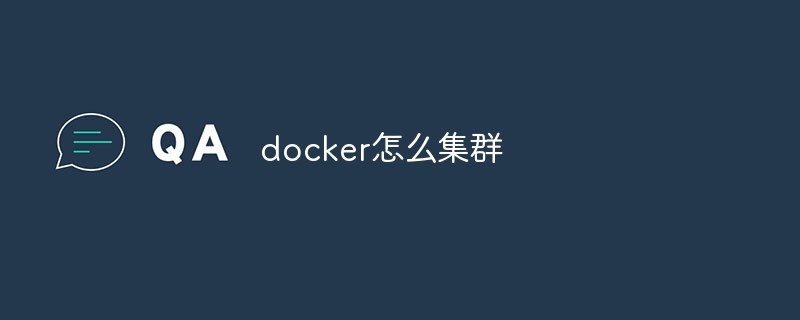How to cluster docker
Docker clustering is a distributed container management system that connects multiple hosts, allowing users to scale capacity, improve availability and simplify management. Creating a Docker cluster includes installing Docker Engine, creating a cluster network, joining a cluster, and deploying containers. Docker Swarm and Kubernetes are both tools for managing clusters, Swarm is suitable for small and medium clusters, and Kubernetes has more advanced features. The benefits of Docker clusters include scalability, high availability, simplified management, resource optimization, and rapid deployment.

Detailed explanation of Docker cluster
What is a Docker cluster?
A Docker cluster is a connection between multiple Docker hosts and managing and running Docker containers in a distributed way. It allows users to expand container capacity, improve availability and simplify container management.
How to create a Docker cluster?
The basic steps for creating a Docker cluster are as follows:
- Install Docker Engine: Install Docker Engine on all hosts.
- Create a cluster network: Create a cluster network using Docker Swarm or Kubernetes to allow host communication.
- Join Cluster: Join each host to the cluster to make it a member of the cluster.
- Deploy containers: Deploy containers in a cluster and they will run on different hosts.
- Manage clusters: Use Docker Swarm or Kubernetes to manage clusters, including adding or removing hosts, deploying updates, and monitoring cluster health.
Docker Swarm and Kubernetes: Cluster Management Tools
- Docker Swarm: Docker native cluster management tool, simple and easy to use, suitable for small and medium clusters.
- Kubernetes: A mature, feature-rich cluster management tool with advanced features such as automatic scaling, self-healing, and advanced scheduling.
Benefits of Docker clusters
Docker clusters offer the following benefits:
- Scalability: Easily scale cluster capacity by adding more hosts.
- High Availability: In the event of a host failure, the container will automatically restart on other hosts to ensure application availability.
- Simplified management: Use cluster management tools to centrally manage a large number of hosts and containers.
- Resource optimization: Optimize resource utilization in the cluster through load balancing.
- Rapid Deployment: You can quickly deploy and update containers on any host in the cluster.
The above is the detailed content of How to cluster docker. For more information, please follow other related articles on the PHP Chinese website!

Hot AI Tools

Undresser.AI Undress
AI-powered app for creating realistic nude photos

AI Clothes Remover
Online AI tool for removing clothes from photos.

Undress AI Tool
Undress images for free

Clothoff.io
AI clothes remover

Video Face Swap
Swap faces in any video effortlessly with our completely free AI face swap tool!

Hot Article

Hot Tools

Notepad++7.3.1
Easy-to-use and free code editor

SublimeText3 Chinese version
Chinese version, very easy to use

Zend Studio 13.0.1
Powerful PHP integrated development environment

Dreamweaver CS6
Visual web development tools

SublimeText3 Mac version
God-level code editing software (SublimeText3)

Hot Topics
 How to exit the container by docker
Apr 15, 2025 pm 12:15 PM
How to exit the container by docker
Apr 15, 2025 pm 12:15 PM
Four ways to exit Docker container: Use Ctrl D in the container terminal Enter exit command in the container terminal Use docker stop <container_name> Command Use docker kill <container_name> command in the host terminal (force exit)
 How to copy files in docker to outside
Apr 15, 2025 pm 12:12 PM
How to copy files in docker to outside
Apr 15, 2025 pm 12:12 PM
Methods for copying files to external hosts in Docker: Use the docker cp command: Execute docker cp [Options] <Container Path> <Host Path>. Using data volumes: Create a directory on the host, and use the -v parameter to mount the directory into the container when creating the container to achieve bidirectional file synchronization.
 How to check the name of the docker container
Apr 15, 2025 pm 12:21 PM
How to check the name of the docker container
Apr 15, 2025 pm 12:21 PM
You can query the Docker container name by following the steps: List all containers (docker ps). Filter the container list (using the grep command). Gets the container name (located in the "NAMES" column).
 How to restart docker
Apr 15, 2025 pm 12:06 PM
How to restart docker
Apr 15, 2025 pm 12:06 PM
How to restart the Docker container: get the container ID (docker ps); stop the container (docker stop <container_id>); start the container (docker start <container_id>); verify that the restart is successful (docker ps). Other methods: Docker Compose (docker-compose restart) or Docker API (see Docker documentation).
 How to start mysql by docker
Apr 15, 2025 pm 12:09 PM
How to start mysql by docker
Apr 15, 2025 pm 12:09 PM
The process of starting MySQL in Docker consists of the following steps: Pull the MySQL image to create and start the container, set the root user password, and map the port verification connection Create the database and the user grants all permissions to the database
 How to update the image of docker
Apr 15, 2025 pm 12:03 PM
How to update the image of docker
Apr 15, 2025 pm 12:03 PM
The steps to update a Docker image are as follows: Pull the latest image tag New image Delete the old image for a specific tag (optional) Restart the container (if needed)
 How to create containers for docker
Apr 15, 2025 pm 12:18 PM
How to create containers for docker
Apr 15, 2025 pm 12:18 PM
Create a container in Docker: 1. Pull the image: docker pull [mirror name] 2. Create a container: docker run [Options] [mirror name] [Command] 3. Start the container: docker start [Container name]
 How to view the docker process
Apr 15, 2025 am 11:48 AM
How to view the docker process
Apr 15, 2025 am 11:48 AM
Docker process viewing method: 1. Docker CLI command: docker ps; 2. Systemd CLI command: systemctl status docker; 3. Docker Compose CLI command: docker-compose ps; 4. Process Explorer (Windows); 5. /proc directory (Linux).






